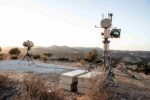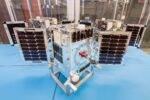Lockheed Martin has announced plans to conduct the first flight test of its space-based interceptor by 2028 as part of the U.S. Missile Defense Agency’s (MDA) “Golden Dome” initiative. The program aims to establish a kinetic kill capability in space to defeat advanced missile threats—including hypersonic glide vehicles and maneuverable reentry vehicles—before they reach U.S. territory or allied assets.
Golden Dome: A Strategic Pivot Toward Space-Based Missile Defense
The Golden Dome program represents a significant doctrinal shift in U.S. missile defense strategy by focusing on intercepting threats from orbit rather than relying solely on terrestrial or airborne systems. Officially known as the “Space-based Interceptor Layer,” this initiative is part of a broader MDA effort to build an integrated multi-domain architecture capable of countering next-generation missile threats from China, Russia, North Korea, and Iran.
Unlike ground- or sea-launched interceptors such as the Ground-based Midcourse Defense (GMD) system or Aegis BMD with SM-3/SM-6 missiles, the Golden Dome concept envisions deploying maneuverable interceptors into low Earth orbit (LEO), where they can remain on-station and engage targets during their boost or midcourse phase. This approach offers significant advantages against hypersonic glide vehicles (HGVs), which travel at high speeds but within altitudes that make them difficult to track and intercept using conventional systems.
Rear Adm. Doug Williams, MDA’s deputy director, previously emphasized that “a persistent presence in space is critical for defeating emerging missile threats that exploit gaps in our terrestrial defense layers.” The 2024 National Defense Authorization Act allocated $1.5 billion over five years for initial development of the Golden Dome architecture.
Lockheed Martin’s Role and Technical Approach
Lockheed Martin was selected in early 2024 as one of two prime contractors—alongside Northrop Grumman—to develop prototype space interceptors under competitive contracts worth up to $300 million each over three years. According to company officials speaking at the 2025 Space Symposium in Colorado Springs, Lockheed’s design leverages its heritage from programs such as THAAD and Next Generation Interceptor (NGI), while incorporating novel propulsion and guidance technologies tailored for exoatmospheric engagements.
The planned interceptor will feature:
- A high-performance kinetic kill vehicle (KKV) capable of hit-to-kill engagements at closing speeds exceeding Mach 20
- Advanced divert-and-attitude control systems (DACS) using cold gas or solid propellants for rapid maneuverability
- Onboard autonomous targeting algorithms using AI-enhanced sensor fusion
- Compatibility with future space-based sensor networks such as Hypersonic and Ballistic Tracking Space Sensor (HBTSS)
The company has reportedly completed preliminary design review (PDR) milestones ahead of schedule and is preparing for critical design review (CDR) by late 2026. If successful, Lockheed could begin orbital deployment testing by late FY28 from launch platforms such as Falcon 9 or Vulcan Centaur.
Threat Landscape Driving Urgency
The urgency behind Golden Dome stems from evolving adversary capabilities—most notably China’s DF-ZF HGV system launched aboard DF-17 missiles and Russia’s Avangard-equipped ICBMs. Both systems are designed to evade radar tracking through unpredictable flight paths at altitudes between 40–100 km—too high for traditional air defenses but too low for many existing exoatmospheric interceptors.
In addition to HGVs, maneuverable reentry vehicles (MaRVs), fractional orbital bombardment systems (FOBS), and potential anti-satellite weapons further complicate defense planning. The Pentagon’s latest Missile Defense Review explicitly calls out these challenges and highlights the need for persistent sensing and interception capabilities above Earth’s atmosphere.
A successful space-based interceptor would allow earlier engagement windows—potentially during an adversary missile’s boost phase—and provide global coverage without reliance on regional basing rights or forward-deployed assets vulnerable to preemptive attack.
Integration with Broader Missile Defense Architecture
MDA envisions that Golden Dome will not operate in isolation but instead integrate tightly with other elements including:
- HBTSS: A constellation of infrared tracking satellites providing real-time target data across all phases of flight
- C4ISR Backbone: Leveraging Link-16/STANAG protocols across joint forces for rapid fire control handoff
- Terrestrial Systems: Including NGI-equipped GMD sites in Alaska/California and mobile THAAD batteries
This layered approach aligns with Joint All-Domain Command & Control (JADC2) principles emphasizing sensor-shooter integration across domains. Lockheed engineers have confirmed that their interceptor will be JADC2-compliant with open mission systems architecture allowing plug-and-play upgrades over time.
Skepticism Remains Over Feasibility and Cost
Despite its promise, critics question whether deploying kinetic interceptors into orbit is technically feasible—or cost-effective—in the near term. Past attempts at similar concepts such as Brilliant Pebbles during the Strategic Defense Initiative era were canceled due to budget overruns and technical immaturity.
The challenge lies not only in achieving reliable hit-to-kill capability from orbit but also managing logistics such as refueling/replacement cycles, debris mitigation under SSA rules, satellite survivability against ASAT attacks, and latency issues in command-and-control loops.
A Congressional Budget Office report released mid-2025 estimated that a minimal operational constellation might require at least two dozen interceptors costing upwards of $15 billion over a decade—not including launch costs or replenishment cycles after use or obsolescence.
The Road Ahead Toward Operational Capability by Early 2030s
If Lockheed’s timeline holds—with first test flights by FY28—the path toward an operational constellation could begin around FY31–32 pending successful demonstrations. MDA has stated it may downselect between competing designs after initial orbital tests before awarding full-rate production contracts post-2030.
The outcome could reshape global deterrence dynamics by introducing credible active defenses against previously uncounterable weapons classes like HGVs—a move likely to spur both arms races in countermeasures and renewed debates over weaponization of outer space under international law frameworks like the Outer Space Treaty.
For now, Lockheed Martin’s progress marks one step closer toward realizing what was once science fiction—a persistent orbital shield capable of striking down missiles before they threaten lives below.










